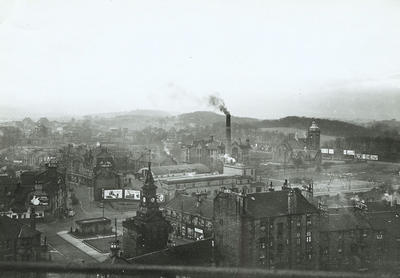
A view of Pollokshaws, looking south-west from the tower of St Conval's Church in 1958. This is one of a series of photographs taken by Glasgow Corporation's Architectural and Planning Department prior to the wholesale redevelopment of Pollokshaws in the 1960s.
In the foreground is the clock tower of the old Townshouse, with Shawbridge Street leading off into the distance from the square in front. Pollokshaws Baths and washhouse is in the centre of the picture, while further to the right can be seen the Sir John Maxwell School and Pollokshaws Burgh Hall.
The inhabitants of Pollokshaws retained a distinctive identity long after the burgh was absorbed into Glasgow in 1912. "The queer folk o' the 'Shaws" was a nickname which was immortalised in a mid-19th century folksong, describing the experiences of a Glasgow visitor to Pollokshaws races. It is said to have originated from Flemish weavers who came to live in Pollokshaws. They were called queer because no one could understand them.
Reference: Glasgow City Archives, AP9/7/28/35
Reproduced with the permission of Glasgow City Council, Libraries Information and Learning
Keywords:
Architectural and Planning Department, churches, clock towers, clocks, Flemish weavers, folk songs, halls, horse races, horse racing, nicknames, Pollokshaws Burgh Hall, Pollokshaws races, Pollokshaws Townshouse, primary schools, public baths, queer folk o' the 'Shaws, Sir John Maxwell Primary School, Sir John Maxwell School, St Conval's Church, wash-houses
You have 7 images in your photo album.